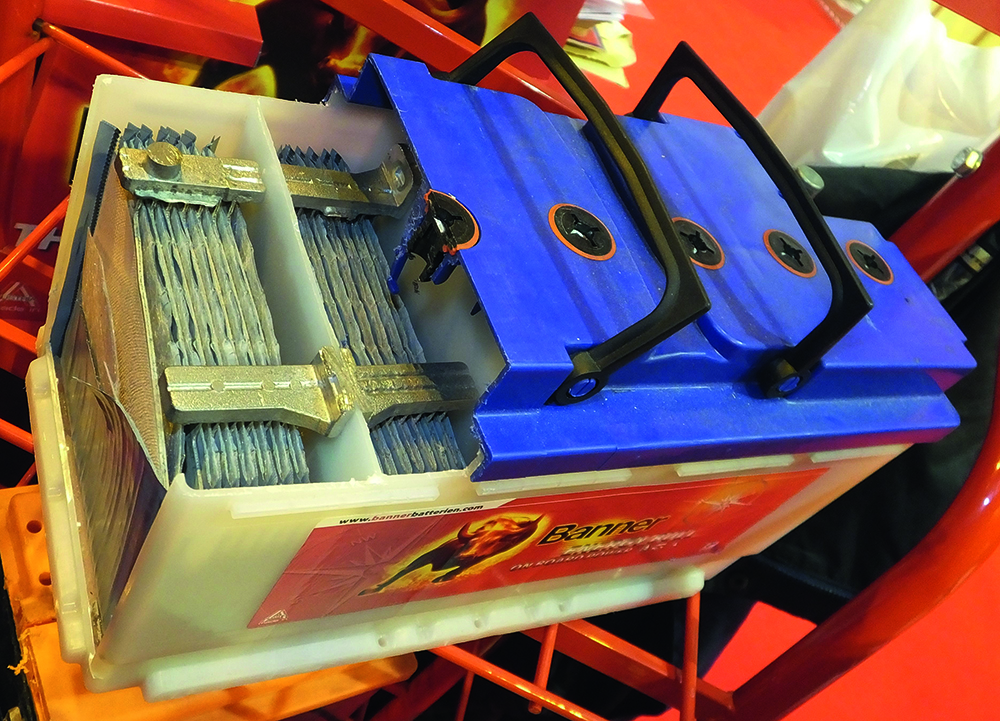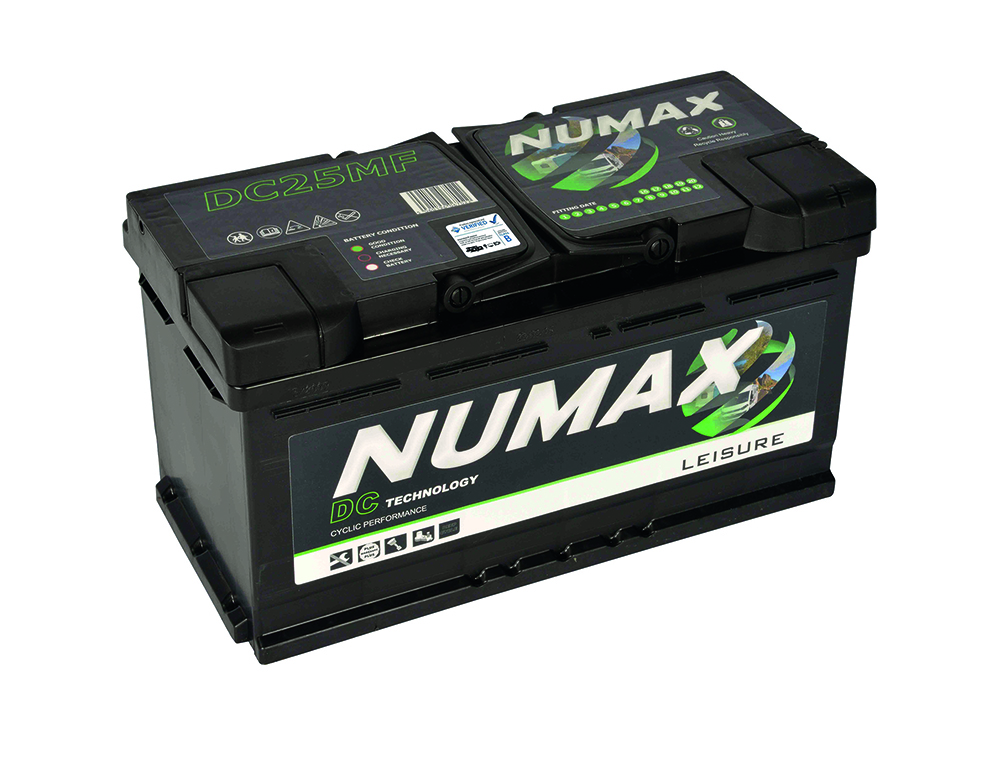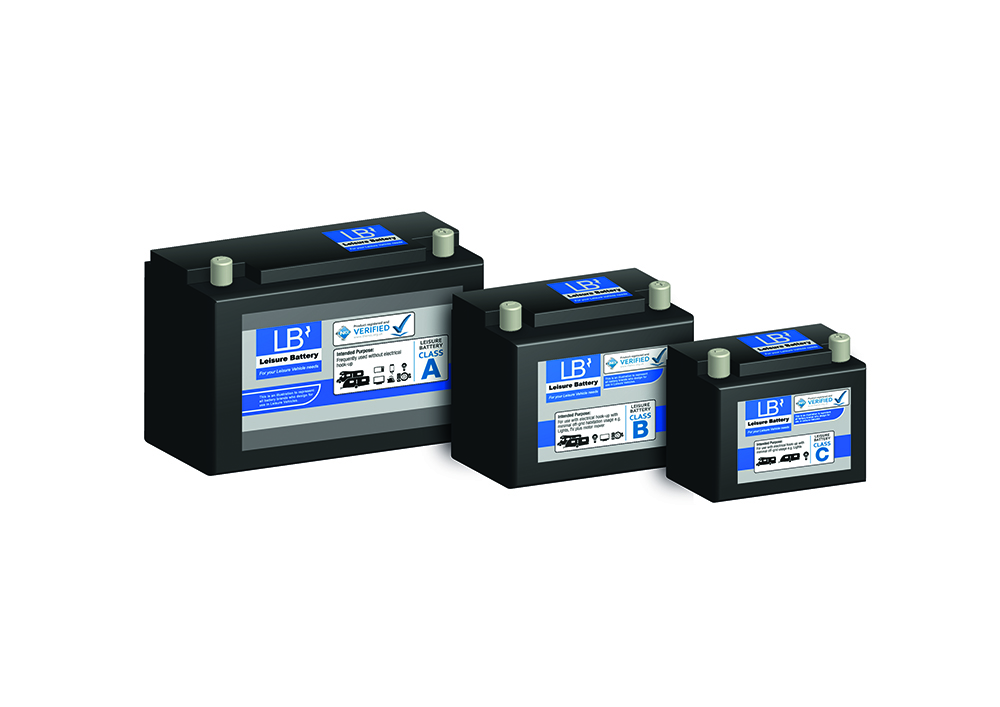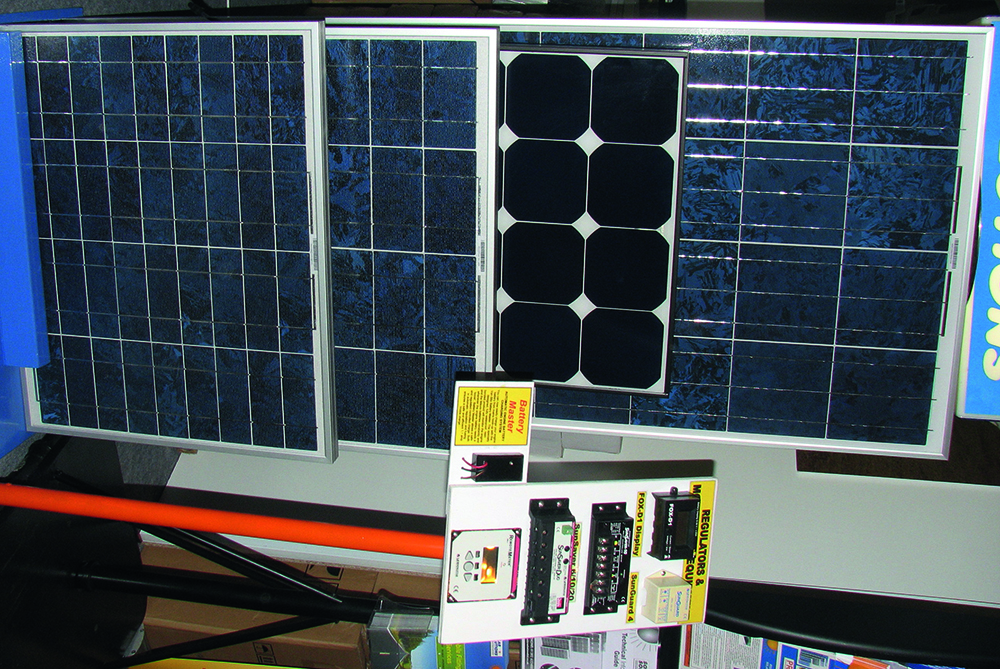Motorhome advice: How to get the most out of your leisure battery
 Modern motorhomes rely on leisure batteries to make the living area operate smoothly and keep us warm and cosseted. We expect so much more nowadays and if it’s not a ‘home from home’ then we think that something is missing.
Modern motorhomes rely on leisure batteries to make the living area operate smoothly and keep us warm and cosseted. We expect so much more nowadays and if it’s not a ‘home from home’ then we think that something is missing.
Systems have evolved to maintain leisure batteries in the best way possible. But have batteries evolved similarly over this time?
Starter or leisure batteries for motorhomes and campervans?
For the majority of motorhomes and campervans, the basis of the battery remains lead. Battery manufacturers make many thousands of batteries for the automotive industry and, with this comes the economies of scale, so it is not surprising that we are frequently offered starter batteries for leisure use, often badged as leisure batteries. But is this OK?
A lot depends on your particular motorhoming lifestyle. If you go from one campsite with a hook-up to another campsite with a hook-up then a starter battery is probably as good as you require. If you like exploring places in the wild with no support other than what you bring with you, then you might require a lot more from your battery.
A starter battery is designed to be able to give out hundreds of amps for a few seconds and to start a cold engine. Once the engine has started then the vehicle alternator quickly pumps lots of amps back into the battery to refill it.
Lead acid batteries work by a chemical reaction between two slightly differently formulised lead paste plates sat in a solution of sulphuric acid. In order to get lots of amps out, lots of surface area is needed and this is achieved by having lots of interleaved thin plates. A lead grid in each supports the paste.
Starter batteries are not designed to be discharged significantly for long periods as this causes the plates to weaken and the paste to progressively fall out.
Deep-cycle batteries in motorhomes and campervans
There is a much smaller market for deep-cycle batteries, which are typically used in applications such as electrically powered forklift trucks and old milk floats. Smaller versions of these are used in electric golf buggies and the like.
These batteries have thicker plates, or other forms of construction, to retain the paste in position and tend to be more labour intensive to manufacture and, consequently, cost a lot more per rated ampere hour (the Ah rating is the capacity of a battery).
They are, however, ideally suited to those who want extended electrical independence in their motorhome or campervan. Much has been done to improve the life of batteries generally including turning the acid into a gel (GEL) and also having a layer of absorbent fibreglass mat between each plate (AGM) to both retain the acid and keep the paste in place.
Also, calcium has been introduced into the formulation as a way of reducing battery gassing and maintenance requirements. Some batteries incorporate a small amount of tin into the plates, too, and this is said to make the battery more tolerant to being on constant trickle charge, such as when connected via a simple regulator to a solar panel.
 The best battery for motorhomes and campervans
The best battery for motorhomes and campervans
Most manufacturers make a range of batteries for different applications. Take Banner, for example, a well-respected manufacturer. Banner sells three basic lines: Energy Bull, Running Bull AGM and Traction Bull Block GEL.
On the basis of never discharging the battery below 50% of its published Ah capacity (which is recommended to prolong its life), then the number of times you can do this is a good yardstick of the battery’s durability. Banner quotes 270 cycles for the Energy Bull, 360 cycles for the Running Bull AGM and 900 cycles for the Traction Bull Block GEL.
Numax, a battery range produced by Ecobat Battery Technologies – formally Manbat – is already well-established in the motorhome world. Its batteries are all verified under the National Caravan Council’s (NCC) Verified Leisure Battery Scheme. A spokesman explained that it has created a battery – the 105Ah DC31MF – specifically for motorhomes. But he pointed out that the crème de la crème of its range is the dual-purpose XD series and specifically the super cyclic performance-orientated XDT, which features tubular plates and can deliver up to 1,000 plus cycles.
So, you need to look deeper than just the name. But just be sure that if you discharge your battery until the lights dim each time, then the life of the battery in terms of charge-discharge cycles will be a lot less. Companies like Trojan sell batteries that are better regarding cycle life, with the worst deep-cycle battery delivering 600 cycles and the best industrial range 2,800 cycles at a 50% depth of discharge.
All this comes at a price, though, and you have to consider if it’s economical to get an expensive battery or accept the life of an inexpensive one and replace it more frequently.
 Verified Battery Scheme
Verified Battery Scheme
The NCC has a Verified Battery Scheme to do some of this thinking for us and guide us in the right direction. It has set three yardsticks for lead-based batteries and established three categories. These are:
- Category A is for batteries with a higher storage capacity and cycle life for people who frequently use their ’van away from hook-up.
- Category B batteries are aimed at those who frequently use campsites with hook-up facilities, but require a greater battery capacity to operate power-hungry devices.
- Category C batteries are for users who require a lower capacity battery to cover basic operation of their habitation equipment for short periods away from hook-up.
The NCC scheme is designed to bring transparency to the leisure battery marketplace and help consumers select a product that’s right for them. A list of all the batteries that have had their performance and cycle life verified can be downloaded from the NCC website. Many battery retailers display an NCC sticker on their batteries so it can be recognised and give important data on that battery and what duty it is considered suitable for.
Looking after batteries
Many batteries, like AGM and GEL units, are maintenance free. But there are a significant proportion that still have a wet electrolyte, which needs regular checking and, if necessary, topping up with de-ionised water.
One advantage of a wet battery is that you can remove a cell top and check the battery’s state of charge by measuring the density of the sulphuric acid within using a hydrometer. Take care doing this as the acid burns. The typical charged density is 1.280, while 1.150 means it’s near flat.
The charging systems on motorhomes while driving has, for many years, been an extension of the starter battery charging system using a relay that links the starter and leisure battery together when the alternator is charging. Because the leisure battery is often further away from the alternator than the starter battery, it can take a while for the leisure battery to get fully charged.
Companies such as Sterling, Votronic and NDS have produced electronic battery-to-battery charging modules (B2B) that make up for this cable loss and provide much quicker leisure batteries charging. Sargent has even designed this feature into its basic electrical system.
Smart alternators
Some modern vehicles automatically turn off the engine when stopped, for example, at the traffic lights, then restart it when the clutch is depressed or foot removed from the brake pedal. These ‘stop-start’ engines could cause havoc with traditional leisure battery charging systems.
Also, we have ‘intelligent’ or ‘smart’ alternators that vary their output depending on engine load. When you slow down, these put your alternator into a maximum charge mode and can pump out up to 200A into the starter battery, pushing its voltage skywards, but assisting the vehicle deceleration. Immediately after slowing down, these can stop charging completely (thus relieving the engine of work to save energy) until the battery voltage has fallen to more traditional levels of around 12.6V.
The latest variants of the B2B charging modules and the features within the latest Sargent electrical systems have taken all this into consideration. Hymer uses a Votronic B2B for this, but Sterling leads the field in this technology.
Jonas Domaschka of Votronic commented: “The energy management of today’s vehicles is very sensitive to external influences. So, if you add power electronics such as a battery-to-battery booster/charger, you have to take care of the sensitive part of the system. The power for the charging converter is supplied by the vehicle’s starter circuit (generator with starter battery). There is no intervention into the starter circuit itself. The device pretends to be a strong consumer for the generator. The automatic power control gives the required safety and ensures the vehicle’s starting ability. Depending on the driving condition, the voltage of modern Euro VI and VI+ vehicles with energy-saving, intelligent generators can fluctuate considerably (from 12.6V to 15.5V). These fluctuations are handled by the charger converter to ensure uniform charging of the leisure battery and protection of the 12V loads.”
“It’s worth noting that the start-stop ability of most vehicles is only available under specific conditions. For example, it won’t work if it is too hot or cold outside, due to the high power consumption of the heater or the air-conditioning.”
 Battery size
Battery size
If you are set on wild camping, then it’s best to start with a motorhome that is as economical on battery power as possible. So, consider one that uses gas for water and space heating and has a fridge that will run on gas. Then make sure all your lighting is LED-based.
If your leisure battery lasts a week before the voltage drops to around 12V (50% of load voltage) and you want to last two weeks then, if you have both the space and the payload, add another matching battery and connect them in parallel, each with its own fuse. These must be of the same type (wet, GEL or AGM) and are best as a matched pair of the same age.
The gentler you discharge a battery, the more capacity it will deliver, so having two connected in parallel will provide more capacity than using one and then switching to the other.
Alternatively, connect a pair of matching 6V batteries in series. Make sure that the batteries are properly vented. Most have a little pipe on the side that a plastic tube can be fitted through and routed outside. If you double up on your batteries, ensure that both the positive and negative cables are at least as substantial as those that feed the motorhome.
If you have added a large inverter (to run devices like a microwave) then the battery paralleling cables and battery fuses will all need to be much bigger. The size of the cables supplied with the inverter should be the minimum size you use for paralleling. Never extend inverter cables, as the voltage drop is significant at the high currents large inverters take.
Safety is always paramount when doing anything with batteries. Always disconnect the negative connection from the battery first – this is because, should your spanner accidently touch motorhome metalwork, there will not be a spark as this is also where the negative is connected to. If you have more than one leisure battery, then disconnect all the negatives first. When you have finished working on the electrics, reconnect the negatives last. Ensure that any battery is always properly secured in position.
Top it up with solar
You could fit a solar panel as, during the summer months, a 100W panel mated to a suitable regulator, should sustain most people, unless you use a large inverter and microwave, toaster, or even worse a hairdryer.
One word of warning: on some modern motorhomes there is a dedicated input point on the electrical system for ‘solar’. If you do not use this input then the electrical fuel gauge feature in your motorhome may indicate your battery is empty when in reality it is full.
Lithium iron batteries
There’s the new breed of lithium iron phosphate batteries that have many benefits thanks to their longer cycle life (10 or more times that of lead-based batteries) even when discharged regularly to 80%. They can be charged and discharged at greater currents and are safer as they have no wet electrolyte to spill. They are also much lighter than a lead-acid battery.
The downside is the cost, typically £10 for each ampere hour. However, costs are falling as popularity rises, as Andy Harris of RoadPro, says, “We’ve installed many dozens of different lithium systems... and more manufacturers have fitted them.”
*This feature is sponsored by Ecobat Battery Technologies.

This feature was originally published in the August 2018 issue of MMM magazine. Want to read more like it? Subscribe to MMM magazine today.







.jpg)




Recent Updates
Engine management lights: all you need to know
What is the engine management light? What does it mean, and what do I have to do? ...
Motorhome air suspension: all you need to know
Motorhomes are heavy and the additional weight of equipment and height of the bodywork can increase the loads ...
Motorhome WiFi: how to get better motorhome internet
Staying connected on the move is more and more essential, so relying on campsite WiFi isn't an option – here ...
A class of their own - our guide to A-class motorhomes
Thinking of trading up to an A-class, or even going straight to the top of the motorhome tree? We guide you ...
Explore overseas on a motorhome dream tour
Enjoy exotic travel in a campervan or motorhome by hiring, swapping with someone else or exporting your ...
Motorhome water systems: everything you need to know
On-board water is an important part of every motorhome – here’s everything you need to know ...
Campervanning in Europe: what you need to know
Whether you're planning a leisurely drive through the French countryside, navigating bustling city streets in ...
Campervan security: all you need to know
With thefts on the increase, it’s important to know how to keep your campervan secure and prevent campervan ...
Campervan furniture: everything you need to know
Our campervan experts guide you through all the essentials for your campervan, including tables, chairs, ...
Campervan finance: how to fund your purchase
Here we look at the different types of campervan finance available, to help you decide what’s the best option ...
Other Articles
Britain’s best used motorhomes
Want a great motorhome without paying the premium for a new one? Here's a guide to the best you can get in the pre-owned market for each layout, ...
Which motorhome? Choosing the perfect motorhome for you
Choosing a motorhome or campervan is one of the biggest buying decisions you’ll ever make, so it's important ...
Campervan washroom essentials: stay fresh on the road
Our guide will take you through the campervan washroom essentials you'll need so you're well-prepared for ...
Dogs in campervans: all you need to know
Follow our advice and your dog will enjoy campervanning as much as you do ...
Electric campervans: all you need to know
Our guide will take you through everything you need to know about electric campervans and what the future ...
Motorhome electrics: a complete guide to your motorhome electrical set-up
Motorhome electrics can dramatically enhance the convenience and comfort of your vehicle – but they can be ...
Lighting for campervans: all you need to know
We guide you through all the lighting options available for you and your campervan, including interior ...
Electric bikes for motorhomes: our ultimate guide
Read our comprehensive guide to electric bikes for motorhome owners, helping you add electric power to your ...
Our guide to 'cheap' motorhomes in 2024
If you're on the hunt for an affordable new motorhome, this is the best place to start – we've rounded up a ...
Campervans in winter: all you need to know
Here's your guide to preparing your campervan for the colder months, whether you will be using it or putting ...